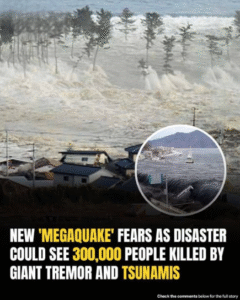Japan is on high alert following a chilling new scientific report that warns of an 82% chance of a catastrophic megaquake striking within the next few decades—an event that could potentially kill up to 300,000 people and cause unprecedented destruction.
The prediction, made by top seismologists and disaster preparedness experts in Japan, focuses on the feared Nankai Trough, a vast undersea fault line stretching off the southern coast of Honshu and Shikoku islands. Historically, this region has produced some of the most powerful earthquakes in Japanese history, and experts say it is due for another.
According to the Earthquake Research Committee, the risk of a magnitude 8 to 9 earthquake occurring along the Nankai Trough within the next 30 years is a staggering 80–82%. The last massive quake in the region occurred in 1946, and researchers fear pressure has been quietly building for nearly eight decades.
If such a quake were to strike, it could unleash towering tsunamis over 30 meters high (nearly 100 feet), devastating coastal cities and towns. The government’s worst-case scenario outlines over 300,000 deaths, millions displaced, and economic losses topping trillions of dollars. Key infrastructure—roads, hospitals, power grids, and ports—would be severely impacted, paralyzing the nation.
Experts say the densely populated cities of Osaka, Nagoya, and even Tokyo could feel severe tremors, while the hardest-hit areas would likely be in Kochi, Tokushima, and Shizuoka Prefectures. Casualty numbers could rise sharply depending on the time of day, the weather, and the effectiveness of emergency responses.
In response, Japan is accelerating preparations. Nationwide disaster drills are being held more frequently. New tsunami walls are being built. Cities are being urged to upgrade aging infrastructure and improve early-warning systems. Emergency broadcast networks are being tested, and families are being urged to prepare emergency kits and evacuation plans.
Despite the frightening numbers, scientists stress that preparation can save lives. Japan is one of the most earthquake-prone countries in the world but also one of the most resilient. Strict building codes, real-time alert systems, and public awareness campaigns have drastically improved outcomes in recent decades.
Still, the emotional toll of the warning is real. Memories of the 2011 Tōhoku earthquake and tsunami—which killed over 15,000 people and caused the Fukushima nuclear disaster—are fresh. Many Japanese citizens are bracing themselves for what could be another national tragedy.
Authorities continue to emphasize: the quake is not guaranteed to happen tomorrow, but the odds are dangerously high, and complacency is not an option. The country remains vigilant, balancing daily life with quiet but serious preparation for what could be Japan’s next great test.


